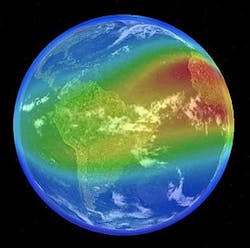HFGeo ELINT program to pinpoint HF transmitters extends to advanced ionospheric modeling
WASHINGTON, 30 Sept. 2012. Electronic intelligence (ELINT) experts at the U.S. Intelligence Advanced Projects Agency (IARPA) in Washington are asking industry to develop advanced computer modeling techniques of the ionosphere as part of a program to detect, pinpoint, and characterize high frequency (HF) signals from potentially hostile radar and communications systems refracted from the ionosphere.
IARPA, the research arm of the Office of the Director of National Intelligence, are interested in complex ionospheric modeling as part of the High Frequency Geolocation and Characterization (HFGeo) Advanced HF Signal Processing program to detect and pinpoint HF signals from radar and communications systems anywhere in the world.
IARPA issued a broad agency announcement (IARPA-BAA-12-04) Friday for the HFGeo Phase 1B signals intelligence (SIGINT) program, which seeks advanced ionospheric modeling techniques -- the third part detailed thus far of the HFGeo program.
Two companies -- Systems & Technology Research LLC in Winchester, Mass.; and the Northrop Grumman Corp. Information Systems segment in Chantilly Va. -- have been chosen so far for the HFGeo program. Systems & Technology Research is concentrating on antenna technology, and Northrop Grumman is researching signal processing.
The ionospheric modeling component of the HFGeo program should run from February 2013 to February 2015, IARPA officials say. Companies interested in bidding for the job should respond to IARPA no later than 12 Nov. 2012.
Locating radar and communications systems that rely on HF signals is particularly difficult to do. Many RF signals, such as VHF and UHF, are relatively easy to locate because they travel only in straight lines, and cannot easily penetrate barriers such as tall buildings and mountain ranges. HF radio signals, on the other hand, behave in a more complex manner and are much more difficult to locate.
HF radio waves not only follow line-of-sight paths, but they also bounce off of layers Earth's upper atmosphere called the ionosphere and come back to the Earth's surface where antennas tuned to HF frequencies -- roughly 2 to 30 MHz -- can pick them up.
HF signals are particularly prone to interference because antennas literally can receive their signals from different directions and at different times because of the ionospheric bounce phenomenon. The ionosphere is ionized by solar radiation and helps propagate HF radio signals to distant locations, hence the long distances that shortwave and Ham HF radio signals can travel.
The IARPA HFGeo program seeks to geolocate and characterize HF emissions accurately. Ionospheric variation,high noise levels, and ionospheric polarization rotation, multipath induced signal fading, and simultaneous multiple angles-of-arrival will make this job challenging for sensors and signal processing experts at Systems & Technology Research Northrop Grumman Information Systems.
Systems & Technology Research and Northrop Grumman seek to capitalize on advances in high-dynamic-range receivers, antenna techniques, adaptive signal processing, ionospheric ray path prediction, and improved measurement and modeling techniques to geolocate HF emitters around the world, as well as determine if these signals are involved with benign commercial activity, or are part of hostile communications and radar systems.
For the newest part of the HFGeo program, IARPA scientists are looking for improved ways to understand HF skywave propagation in the ionosphere along the ray path by measuring and modeling the lower ionosphere where refraction occurs.
The goals of the IARPA HFGeo program include developing the ability to resolve several angles-of-arrival and polarization states accurately through novel antenna concepts; enhance signal-to-noise ratio and signal detection with multi-dimensional adaptive signal processing; determine the state of the ionosphere accurately; and integrate these technologies into geolocation and source characterization applications.
While Systems & Technology Research Northrop Grumman Information Systems are concentrating on the first two thrusts of the HFGeo program -- novel antenna concepts and signal processing algorithms -- IARPA is moving on to the next phase of the program, which involves advanced ionospheric modeling.
The focus of this ionospheric modeling program is on the mid latitude region, and generally seeks to avoid Earth's auroral and polar regions and the broad equatorial region near the geomagnetic equator.
Instead, this phase of the HFGeo program focuses on the region between roughly 20 and 70 degrees geomagnetic latitude between the geomagnetic equator and the geomagnetic pole. Some consideration of auroral and polar effects may be necessary, however, IARPA officials point out.
Companies interested in this part of the HFGeo program should respond to IARPA by e-mail at [email protected] no later than 12 Nov. 2012. IARPA officials say they expect to award several contracts.
For questions or concerns contact IARPA's Frank Robey by e-mail at [email protected], or by fax at 301-851-7673. The program's Website is at www.iarpa.gov/solicitations_hfgeo.html.
More information is online at https://www.fbo.gov/notices/762f5d60768112cf327f2d985e7fd995.
Follow Military & Aerospace Electronics and Avionics Intelligence news updates on Twitter

